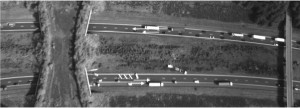Rubbernecking
Tom Vanderbilt passes on and summarizes a new study by researchers at the Delft University of Technology that estimates the effects of “rubbernecking” in adding to traffic congestion after an accident at about 50 percent of free-flow capacity.
As pictured above, a light truck overturned near the city of Apeldoorn. One lane (in the ‘bottom section’ in the photo above) was closed for the sake of emergency response. Not surprisingly, given that a lane was missing, and two lanes had to merge, the researchers a large drop in “outflow capacity” in the section closest to the overturned van.
But what is striking is the airborne researchers observed a sizable effect — roughly a 50% capacity reduction — in the opposite bit of highway, in which no lanes were blocked. The video of this is rather amazing: At roughly the position that affords the best view of the crash, the traffic begins to bunch, as it does in stop-and-go congestion, even though the road ahead is otherwise clear. One vehicle, the “leader” is essentially slowing to look at the incident, creating in essence a backward “shock wave” that everyone else drives into. Once in the slowing wave, their curiosity is no doubt aroused and so they too continue to creep along for a look. At the exact point of the wreck, the traffic again begins to accelerate.
Vanderbilt notes, too, “Thomas Schelling’s description of rubbernecking in the classic book Micromotives and Macrobehavior: Because they’ve already been made to wait because of everyone else’s look, each individual driver feels they too have the right to look themselves. Each person’s five seconds adds up to incremental delays (“it is a bad bargain,” he wrote). If everyone could only agree not to look, the congestion actually would not form.” But, alas, there’s no reason to think others won’t look so, if you’re curious, you might as well. Gresham’s Law and all that.





We call it “gaper’s block” here and in Chicago the phenomenon assumes truly remarkable proportions.
Obi Wan has taught you well.